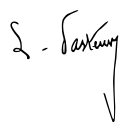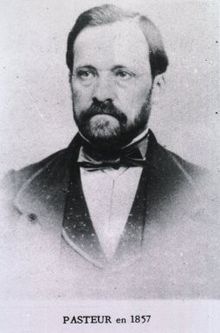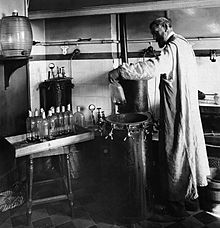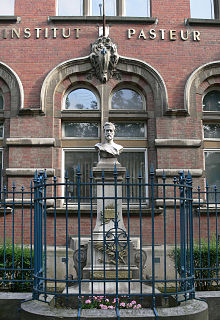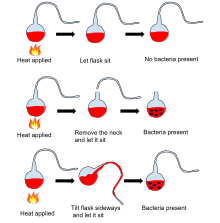Louis Pasteur
| Louis Pasteur | |
|---|---|
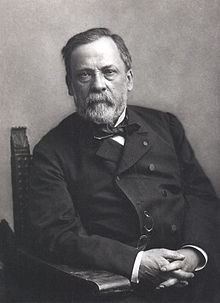
Photograph by Nadar
|
|
| Born | December 27, 1822 Dole, France |
| Died | September 28, 1895 (aged 72) Marnes-la-Coquette, France |
| Nationality | French |
| Fields | |
| Institutions | |
| Alma mater | École Normale Supérieure |
| Notable students | Charles Friedel[1] |
| Notable awards |
|
| Signature | |
Louis Pasteur (/ˈluːi pæˈstɜr/, French: [lwi pastœʁ]; December 27, 1822 – September 28, 1895) was a French chemist and microbiologist renowned for his discoveries of the principles of vaccination, microbial fermentation and pasteurization. He is remembered for his remarkable breakthroughs in the causes and preventions of diseases, and his discoveries have saved countless lives ever since. He reduced mortality from puerperal fever, and created the first vaccines for rabies and anthrax. His medical discoveries provided direct support for the germ theory of disease and its application in clinical medicine. He is best known to the general public for his invention of the technique of treating milk and wine to stop bacterial contamination, a process now called pasteurization. He is regarded as one of the three main founders of bacteriology, together with Ferdinand Cohn and Robert Koch, and is popularly known as the "father of microbiology".[3][4][5]
Pasteur was responsible for disproving the doctrine of spontaneous generation. He performed experiments that showed that without contamination, microorganisms could not develop. Under the auspices of the French Academy of Sciences, he demonstrated that in sterilized and sealed flasks nothing ever developed, and in sterilized but open flasks microorganisms could grow. This experiment won him the Alhumbert Prize of the academy.[6]
Although Pasteur was not the first to propose the germ theory, he developed it and conducted experiments that clearly indicated its correctness and managed to convince most of Europe that it was true. (He was preceded by Girolamo Fracastoro, Agostino Bassi and others, with the significant experimental demonstration by Francesco Redi in the 17th century.) Today, he is often regarded as (one of the) fathers of germ theory.[7]
Pasteur also made significant discoveries in chemistry, most notably on the molecular basis for the asymmetry of certain crystals and racemization. Early in his career, his investigation of Tartaric acid resulted in the first resolution of what we now call optical isomers. His work led the way to our current understanding of a fundamental principal in the structure of organic compounds.
He was the director of the Pasteur Institute, established in 1887, till his death, and his body lies beneath the institute in a vault covered in depictions of his accomplishments in Byzantine mosaics.[8]
Although Pasteur made groundbreaking experiments, his reputation became associated with various controversies. Historical reassessment of his notebook revealed that he practiced deception to overcome his rivals.[9][10]
Contents
[hide]Education and early life
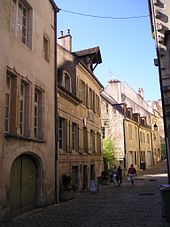
Louis Pasteur was born on December 27, 1822, in Dole, Jura, France, to a Catholic family of a poor tanner. He was the third child of Jean-Joseph Pasteur and Jeanne-Etiennette Roqui. In 1827, the family moved to Arbois, where he entered primary school in 1831. He was an average student in his early years, and not particularly academic, as his interests were fishing and sketching. His pastels and portraits of his parents and friends, made when he was 15, were later kept in the museum of the Pasteur Institute in Paris. In 1838, he left for Paris to join the Institution Barbet, but became homesick and returned in November. In 1839, he entered the Collège Royal de Besançon and earned his baccalauréat (BA) degree in 1840. He was appointed teaching assistant at the Besançon college while continuing a degree science course with special mathematics. He failed his first examination in 1841. He managed to pass the baccalauréat scientifique (general science) degree in 1842 from Dijon but with a poor grade in chemistry. After one failed attempt for the entrance test for the École Normale Supérieure in Paris in 1842, he succeeded in 1844. In 1845 he received the licencié ès sciences (Bachelor of Science) degree. In 1846, he was appointed professor of physics at the Collège de Tournon (now called Lycée Gabriel-Faure) in Ardèche, but Antoine Jérome Balard (one of the discoverers of the element bromine) wanted him back at the École Normale Supérieure as a graduate assistant (préparateur) for chemistry courses. He joined Balard and simultaneously started his research in crystallography and in 1847, he submitted his two theses, one in chemistry and the other in physics. After serving briefly as professor of physics at the Dijon Lycée in 1848, he became professor of chemistry at the University of Strasbourg, where he met and courted Marie Laurent, daughter of the university's rector in 1849. They were married on May 29, 1849, and together had five children, only two of whom survived to adulthood; the other three died of typhoid. These personal tragedies were his motivations for curing infectious diseases.[3][11]
Career
Pasteur was appointed to the Chair of Chemistry in the faculty of sciences of the University of Strasbourg in 1848. In 1854, he was named dean of the new faculty of sciences at Lille University, where he began his studies on fermentation.[12] It was on this occasion that Pasteur uttered his oft-quoted remark: "dans les champs de l'observation, le hasard ne favorise que les esprits préparés." (In the field of observation, chance favors only the prepared mind.[13])
In 1857, he moved to Paris as the director of scientific studies at the École Normale Supérieure where he took control from 1858 to 1867 and introduced a series of reforms to improve the standard of scientific work. The examinations became more rigid, which led to better results, greater competition, and increased prestige. Many of his decrees, however, were rigid and authoritarian, leading to two serious student revolts. During "the bean revolt" he decreed that a mutton stew, which students had refused to eat, would be served and eaten every Monday. On another occasion he threatened to expel any student caught smoking, and 73 of the 80 students in the school resigned.[14]
In 1862, he was appointed professor of geology, physics, and chemistry at the École nationale supérieure des Beaux-Arts, the position which held until his resignation in 1867. In Paris, he established the Pasteur Institute in 1887, in which he was its director for the rest of his life.[4][5][11]
Research
Molecular asymmetry
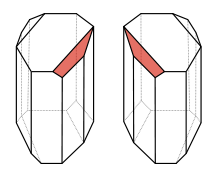
In Pasteur's early work as a chemist, beginning at the École Normale Supérieure, and continuing at Strasbourg and Lille, he examined the chemical, optical and crystallographic properties of a group of compounds known as tartrates.[15] He resolved a problem concerning the nature of tartaric acid (1848).[15][16][17][18][19] A solution of this compound derived from living things (specifically, wine lees) rotated the plane of polarization of light passing through it. The mystery was that tartaric acid derived by chemical synthesis had no such effect, even though its chemical reactions were identical and its elemental composition was the same.[20] Pasteur was able to show not only that optical activity related to the shape of the crystals, but also that an asymmetric internal arrangement of the molecules of the compound was responsible for twisting the light.[12] The (2R,3R)- and (2S,3S)- tartrates were isometric, non-superposable mirror images of each other. This was the first time anyone had demonstrated molecular chirality, and also the first explanation of isomerism.[15] Some historians consider Pasteur's work in this area to be his "most profound and most original contributions to science", and his "greatest scientific discovery."[15]
Fermentation and germ theory of diseases
Pasteur demonstrated that fermentation is caused by the growth of micro-organisms, and the emergent growth of bacteria in nutrient broths is due not to spontaneous generation, but rather to biogenesis (Omne vivum ex vivo "all life from life"). He was motivated to investigate the matter while working at Lille. In 1856 a local wine manufacturer, M. Bigot, the father of his student, sought for his advice on the problems of making beetroot alcohol and souring after long storage.[21] In 1857 he developed his ideas stating that: "I intend to establish that, just as there is an alcoholic ferment, the yeast of beer, which is found everywhere that sugar is decomposed into alcohol and carbonic acid, so also there is a particular ferment, a lactic yeast, always present when sugar becomes lactic acid."[22] According to his son-in-law, Pasteur presented his experiment on sour milk titled "Latate Fermentation" in August 1857 before the Société des Sciences de Lille. (But according to a memoire subsequently published, it was dated November 30, 1857).[23][24] It was published in full form in 1858.[25][26][27] He demonstrated that yeast was responsible for fermentation to produce alcohol from sugar, and that air (oxygen) was not required. He also demonstrated that fermentation could also produce lactic acid (due to bacterial contamination), which make wines sour. This is regarded as the foundation of Pasteur's fermentation experiment and disprove of spontaneous generation of life.
Pasteur's research also showed that the growth of micro-organisms was responsible for spoiling beverages, such as beer, wine and milk. With this established, he invented a process in which liquids such as milk were heated to a temperature between 60 and 100 °C.[28] This killed most bacteria and moulds already present within them. Pasteur and Claude Bernard completed the first test on April 20, 1862.[7] Pasteur patented the process, to fight the "diseases" of wine, in 1865.[28] The method became known as pasteurization, and was soon applied to beer and milk.[29]
Beverage contamination led Pasteur to the idea that micro-organisms infecting animals and humans cause disease. He proposed preventing the entry of micro-organisms into the human body, leading Joseph Lister to develop antiseptic methods in surgery. Lister's work in turn inspired Joseph Lawrence to develop his own alcohol-based antiseptic, which he named in tribute Listerine.[30]
In 1865, two parasitic diseases called pébrine and flacherie were killing great numbers of silkworms at Alais (now Alès). Pasteur worked several years proving that these diseases were caused by a microbe attacking silkworm eggs, and that eliminating the microbe in silkworm nurseries would eradicate the disease.[7]
Pasteur also discovered anaerobiosis, whereby some micro-organisms can develop and live without air or oxygen, called the Pasteur effect.
Spontaneous generation
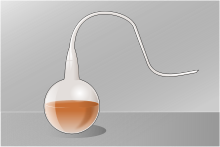
Following his fermentation experiments, Pasteur demonstrated that the skin of grapes was the natural source of yeasts, and that sterilized grapes and grape juice never fermented. He drew grape juice from under the skin with sterilzed needles, and also covered grapes with sterilized cloth. Both experiments could not produce wine in sterilized containers. His findings and ideas were against the prevailing notion of spontaneous generation. He received a particularly stern criticism from Félix Archimède Pouchet, who was director of the Rouen Museum of Natural History. To settle the debate between the eminent scientists, the French Academy of Sciences offered Alhumbert Prize carrying 2,500 francs to whoever could experimentally demonstrate for or against the doctrine.[31][32][33]
To prove himself correct, Pasteur exposed boiled broths to air in swan-neck flasks that contained a filter to prevent all particles from passing through to the growth medium, and even in flasks with no filter at all, with air being admitted via a long tortuous tube that would not allow dust particles to pass. Nothing grew in the broths unless the flasks were broken open, showing that the living organisms that grew in such broths came from outside, as spores on dust, rather than spontaneously generated within the broth. This was one of the last and most important experiments disproving the theory of spontaneous generation for which Pasteur won the Alhumbert Prize in 1862. He concluded that:[34][35]
Never will the doctrine of spontaneous generation recover from the mortal blow of this simple experiment. There is no known circumstance in which it can be confirmed that microscopic beings came into the world without germs, without parents similar to themselves.
Immunology and vaccination
Pasteur's later work on diseases included work on chicken cholera. During this work, a culture of the responsible bacteria had spoiled and failed to induce the disease in some chickens he was infecting with the disease. Upon reusing these healthy chickens, Pasteur discovered he could not infect them, even with fresh bacteria; the weakened bacteria had caused the chickens to become immune to the disease, though they had caused only mild symptoms.[3][7]
His assistant, Charles Chamberland (of French origin), had been instructed to inoculate the chickens after Pasteur went on holiday. Chamberland failed to do this, but instead went on holiday himself. On his return, the month-old cultures made the chickens unwell, but instead of the infections being fatal, as they usually were, the chickens recovered completely. Chamberland assumed an error had been made, and wanted to discard the apparently faulty culture when Pasteur stopped him. Pasteur guessed the recovered animals now might be immune to the disease, as were the animals at Eure-et-Loir that had recovered from anthrax.[36]
In the 1870s, he applied this immunization method to anthrax, which affected cattle, and aroused interest in combating other diseases.
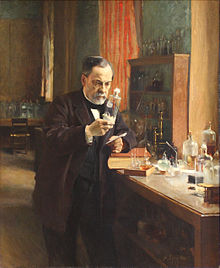
Pasteur publicly claimed he had made the anthrax vaccine by exposing the bacilli to oxygen. His laboratory notebooks, now in the Bibliothèque Nationale in Paris, in fact show that he used the method of rival Jean-Joseph-Henri Toussaint, a Toulouse veterinary surgeon, to create the anthrax vaccine.[20][37] This method used the oxidizing agent potassium dichromate. Pasteur's oxygen method did eventually produce a vaccine but only after he had been awarded a patent on the production of an anthrax vaccine.
The notion of a weak form of a disease causing immunity to the virulent version was not new; this had been known for a long time for smallpox. Inoculation with smallpox (Variolation) was known to result in far less scarring, and greatly reduced mortality, in comparison with the naturally acquired disease. Edward Jenner had also discovered vaccination using cowpox (Vaccinia) to give cross-immunity to smallpox in 1796, and by Pasteur's time this had generally replaced the use of actual smallpox (Variola) material in inoculation. The difference between smallpox vaccination and anthrax or chicken cholera vaccination was that the weakened form of the latter two disease organisms had been "generated artificially", so a naturally weak form of the disease organism did not need to be found. This discovery revolutionized work in infectious diseases, and Pasteur gave these artificially weakened diseases the generic name of "vaccines", in honour of Jenner's discovery. Pasteur produced the first vaccine for rabies by growing the virus in rabbits, and then weakening it by drying the affected nerve tissue.[38]
The rabies vaccine was initially created by Emile Roux, a French doctor and a colleague of Pasteur who had been working with a killed vaccine produced by desiccating the spinal cords of infected rabbits. The vaccine had been tested in 50 dogs before its first human trial.[39][40] This vaccine was first used on 9-year old Joseph Meister, on July 6, 1885, after the boy was badly mauled by a rabid dog.[20][38] This was done at some personal risk for Pasteur, since he was not a licensed physician and could have faced prosecution for treating the boy. After consulting with colleagues, he decided to go ahead with the treatment. Three months later he examined Meister and found that he was in good health.[41] Pasteur was hailed as a hero and the legal matter was not pursued. The treatment's success laid the foundations for the manufacture of many other vaccines. The first of the Pasteur Institutes was also built on the basis of this achievement.[20]
Legal risk was not the only kind Pasteur undertook. In The Story of San Michele, Axel Munthe writes of the rabies vaccine research:
Pasteur himself was absolutely fearless. Anxious to secure a sample of saliva straight from the jaws of a rabid dog, I once saw him with the glass tube held between his lips draw a few drops of the deadly saliva from the mouth of a rabid bull-dog, held on the table by two assistants, their hands protected by leather gloves.
Because of his study in germs, Pasteur encouraged doctors to sanitize their hands and equipment before surgery. Prior to this, few doctors or their assistants practiced these procedures.
Publications
Pasteur's principal published works are:[3]
| French Title | Year | English Title |
|---|---|---|
| Etudes sur le Vin | 1866 | Studies on Wine |
| Etudes sur le Vinaigre | 1868 | Studies on Vinegar |
| Etudes sur la Maladie des Vers à Soie (2 volumes) | 1870 | Studies on Silk Worm Disease |
| Quelques Réflexions sur la Science en France | 1871 | Some Reflections on Science in France |
| Etudes sur la Bière | 1876 | Studies on Beer |
| Les Microbes organisés, leur rôle dans la Fermentation, la Putréfaction et la Contagion | 1878 | Microbes organized, their role in fermentation, putrefaction and the Contagion |
| Discours de Réception de M.L. Pasteur à l'Académie française | 1882 | Speech by Mr L. Pasteur on reception to the Académie française |
| Traitement de la Rage | 1886 | Treatment of Rabies |
Controversies
A French national hero at age 55, in 1878 Pasteur discreetly told his family never to reveal his laboratory notebooks to anyone. His family obeyed and all his documents were held and inherited in secrecy. Finally in 1946 Pasteur's grandson and last surviving male descendant, Pasteur Valley-Radot donated the papers to the French national library (Bibliothèque nationale de France). Yet the papers were restricted for historical studies until the death of Valley-Radot in 1971. The documents were given catalogue number only in 1985. In 1995, the centennial of the death of Louis Pasteur, a historian of science Gerald L. Geison published an analysis of Pasteur's private notebooks in his The Private Science of Louis Pasteur, and declared that Pasteur had given several misleading accounts and played deceptions in his most important discoveries.[9][43] Max Perutz published a defense of Pasteur in The New York Review of Books.[44] Based on further examinations of Pasteur's documents, French immnunologist Patrice Debré concluded in his book Louis Pasteur (1998) that in spite of his genius, Pasteur was sometimes unfair, combative, arrogant, unattractive in attitude, inflexible and even dogmatic.[45][46]
Fermentation
When Pasteur published his theory and experiments on fermentation in 1858, it was not new to science, neither the idea nor the experiment. In 1840 a German chemist Justus von Liebig had noted that yeast could induce fermentation in water. However, he did not know that yeasts were organisms. In 1856 another German, Friedrich Wilhelm Lüdersdorff, reported that yeasts were microorganisms that convert sugar into alcohol.[21] In 1855, Antoine Béchamp, Professor of Chemistry at the University of Montpellier, showed that sugar was converted to sucrose and fructose in a closed bottle containing water and when he added calcium or zinc chloride to it, no reaction occurred. He also noticed moulds developing in the solution, but could not fathom the significance of it. He concluded that water was the factor for fermentation.[47] He changed his conclusion in 1858 that water was not the main factor, in fact, fermentation was directly related to the growth of moulds, and moulds required air for growth. He regarded himself as the first to show the role of microorganisms in fermentation.[48] Pasteur started his experiments only in 1857 and published his findings in 1858 (April issue of Comptes Rendus Chimie, Béchamp's paper appeared in January issue), which, as Béchamp noted, did not bring any novel idea or experiments that earlier works had not shown. On the other hand, Béchamp was probably aware of Pasteur's 1857 preliminary works. With both scientists claiming priority on the discovery, a bitter and protracted dispute lasted throughout their lives. Their rivalry extended to ideas on microbiology, pathogenesis, and germ theory.[49][50] Particularly on the spontaneous generation because Pasteur in his 1858 paper explicitly stated that the lactic acid bacteria (he named them "lactic yeasts"), which caused wine souring, "takes birth spontaneously, as easily as beer yeast every time that the conditions are favourable." This statement directly implied that Pasteur did believe in spontaneous generation. He condemned the ideas of Pasteur as "'the greatest scientific silliness of the age".[22] However, Béchamp was on the losing side, as the BMJ obituary remarked: His name was associated with bygone controversies as to priority which it would be unprofitable to recall.[51] Pasteur and Béchamp believed that fermentation was exclusively cellular activity, that is, it was only due to living cells. But later extraction of enzymes such as invertase by Marcelin Barthelot in 1860 showed that it was simply an enzymatic reaction.[52]
Anthrax vaccine
Pasteur had given a misleading account of the preparation of the anthrax vaccine used in the experiment at Pouilly-le-Fort.[9] The fact is that Pasteur publicly claimed his success in developing anthrax vaccine in 1881.[41] However, his admirer-turned-rival Toussaint was the one who developed the first vaccine. Toussaint isolated the Gram-negative bacteria cholera des poules (later named – to add irony – Pasteurella in honour of Pasteur) in 1879 and gave samples to Pasteur who used for his own works. In 1880 with his publishing on July 12 at the French Academy of Sciences, Toussaint presented his successful result with an attenuated vaccine against anthrax in dogs and sheep.[53] Pasteur purely on grounds of jealousy contested the discovery by publicly displaying his vaccination method in Pouilly-le-Fort on 5 May 1881. The promotional experiment was a success and helped Pasteur sell his products, getting all the benefits and glory.[54][55][56]
Experimental ethics
Pasteur experiments are often cited as against medical ethics, especially on his vaccination of Meister. Firstly, he did not have any experience in medical practice, and more importantly, a medical license. This is often cited as a serious threat to his professional and personal reputation.[57][58] Even his closest partner Dr. Emile Roux refused to participate in the unjust clinical trial.[59] But Pasteur executed vaccination of the boy under the close watch of practising physician Jacques-Joseph Grancher, head of the paediatric clinic at Paris Children's Hospital. He was even not allowed to hold the syringe, although the inoculations were entirely under his supervision.[60] It was Grancher who was responsible for the injections, and defended Pasteur before the French National Academy of Medicine in the issue.[61] Still giving someone a clinical test without proper diagnosis was unjustifiable. (Meister had not shown symptoms of rabies at the time. However, it must be understood, that by the time symptoms appear, death is almost certain, even today.) Secondly, he kept secrecy of his procedure and did not give proper pre-clinical trials. But these accusations were not entirely correct. He disclosed his methods to a small group of scientists. Before using in human, he had successfully vaccinated 50 rabid dogs.[62][63][64]
Awards and honours
Pasteur was awarded the prize of 1,500 francs in 1853 by the Pharmaceutical Society for the synthesis of racemic acid. In 1856 the Royal Society of London presented him the Rumford Medal for his discovery of the nature of racemic acid and its relations to polarized light, and the Copley Medal in 1874 for his work on fermentation. He was elected a Foreign Member of the Royal Society (ForMemRS) in 1869.[2] The French Academy of Sciences awarded him the Montyon Prizes in 1859 for experimental physiology, and the Jecker Prize in 1861[citation needed] and the Alhumbert Prize in 1862[citation needed] for his experimental refutation of spontaneous generation. Though he lost election in 1857 for membership to the French Academy of Sciences, he won it in 1862 in mineralogy section, and was appointed to permanent secretary of the physical science section of the academy in 1887. In 1873 he was elected to the Académie Nationale de Médecine. He was elected to Littré's seat at the Académie française in 1881. In 1883 he became foreign member of the Royal Netherlands Academy of Arts and Sciences.[65]
In 1873 he was made the commander in the Brazilian Order of the Rose.
Pasteur won the Leeuwenhoek Medal, microbiology's highest Dutch honor in Arts and Sciences, in 1895. Both the Institute Pasteur and Université Louis Pasteur were named after him.
He was made a Chevalier of the Legion of Honour in 1853, promoted to Commander in 1868, to Grand Officer in 1878 and made a Grand Cross of the Legion of Honor – one of only 75 in all of France - in 1881.[11]
On June 8, 1886, the Ottoman Sultan Abdul Hamid II awarded Pasteur with the Order of the Medjidie (I Class) and 10000 Ottoman liras.[66]
Legacy
In many localities worldwide, streets are named in his honor. For example, in the USA: Palo Alto and Irvine, California, Boston and Polk, Florida, adjacent to the University of Texas Health Science Center at San Antonio; Jonquière, Québec; San Salvador de Jujuy and Buenos Aires (Argentina), Great Yarmouth in Norfolk, in the United Kingdom, Jericho and Wulguru in Queensland, (Australia); Phnom Penh in Cambodia; Ho Chi Minh City; Batna in Algeria; Bandung in Indonesia, Tehran in Iran, near the central campus of the Warsaw University in Warsaw, Poland; adjacent to the Odessa State Medical University in Odessa, Ukraine; Milan in Italy and Bucharest, Cluj-Napoca and Timișoara in Romania. The Avenue Pasteur in Saigon, Vietnam, is one of the few streets in that city to retain its French name.
Avenue Louis Pasteur in the Longwood Medical and Academic Area in Boston, Massachusetts was named in his honor in the French manner with "Avenue" preceding the name of the dedicatee.[67]
The schools Lycée Pasteur in Neuilly-sur-Seine, France, and Lycée Louis Pasteur in Calgary, Canada, are named after Pasteur. In South Africa, the Louis Pasteur Private Hospital in Pretoria, and Life Louis Pasteur Private Hospital, Bloemfontein, are named after him. Louis Pasteur University Hospital in Košice, Slovakia is also named after Pasteur.
His statue is erected at San Rafael High School in San Rafael, California.
A bronze bust of Pasteur resides on the French Campus of Kaiser Permanente's San Francisco Medical Center in San Francisco. The sculpture was designed by Harriet G. Moore and cast in 1984 by Artworks Foundry.[68]
The UNESCO/Institut Pasteur Medal was created on the centenary of Pasteur's death, and is given every two years in his name, "in recognition of outstanding research contributing to a beneficial impact on human health".[69]
Pasteur Institute
The Pasteur Institute was established by Pasteur to perpetuate his commitment to basic research and its practical applications. He brought together scientists with various specialties. The first five departments were directed by two normaliens (graduates of the École Normale Supérieure): Émile Duclaux (general microbiology research) and Charles Chamberland (microbe research applied to hygiene), as well as a biologist, Élie Metchnikoff (morphological microbe research) and two physicians, Jacques-Joseph Grancher (rabies) and Émile Roux (technical microbe research). One year after the inauguration of the institute, Roux set up the first course of microbiology ever taught in the world, then entitled Cours de Microbie Technique (Course of microbe research techniques). Since 1891 the Pasteur Institute had been extended to different countries, and currently there are 32 institutes in 29 countries in various parts of the world.[70]
Personal life
Faith and spirituality
His grandson, Louis Pasteur Vallery-Radot, wrote that Pasteur had only kept from his Catholic background a spiritualism without religious practice,[71] although Catholic observers often said Louis Pasteur remained throughout his whole life an ardent Christian, and his son-in-law, in perhaps the most complete biography of Louis Pasteur, writes:
Absolute faith in God and in Eternity, and a conviction that the power for good given to us in this world will be continued beyond it, were feelings which pervaded his whole life; the virtues of the gospel had ever been present to him. Full of respect for the form of religion which had been that of his forefathers, he came simply to it and naturally for spiritual help in these last weeks of his life.[72]
Maurice Vallery-Radot, grandson of the brother of the son-in-law of Pasteur and outspoken Catholic, also holds that Pasteur fundamentally remained Catholic.[73] According to both Pasteur Vallery-Radot and Maurice Vallery-Radot, the following well-known quotation attributed to Pasteur is apocryphal:[74] "The more I know, the more nearly is my faith that of the Breton peasant. Could I but know all I would have the faith of a Breton peasant's wife".[3] According to Maurice Vallery-Radot,[75] the false quotation appeared for the first time shortly after the death of Pasteur.[76] However, despite his belief in God, it has been said that his views were that of a freethinker rather than a Catholic, a spiritual more than a religious man.[77][78][79] He was also against mixing science with religion.[80][81]
Death
Pasteur was frequently stricken by strokes beginning in 1868, and the one in 1894 severely impaired his health. Failing to fully recover, he died in 1895, near Paris.[20] He was given a state funeral and was buried in the Cathedral of Notre Dame, but his remains were reinterred in a crypt in the Pasteur Institute in Paris, where the crypt is engraved with his life-saving works.
See also
- Modern medicine
- Infection control
- Infectious disease
- Pasteur Institute
- Pasteurization
- The Story of Louis Pasteur (a 1936 biographical film)
- Ignaz Semmelweis proposed doctors wash their hands in the year 1847
- Listing of the works of Alexandre Falguière
References
- Jump up ^ Asimov, Asimov's Biographical Encyclopedia of Science and Technology 2nd Revised edition
- ^ Jump up to: a b "Fellows of the Royal Society". London: Royal Society. Archived from the original on 2015-03-16.
- ^ Jump up to: a b c d e
 James J. Walsh (1913). "Louis Pasteur". Catholic Encyclopedia. New York: Robert Appleton Company.
James J. Walsh (1913). "Louis Pasteur". Catholic Encyclopedia. New York: Robert Appleton Company. - ^ Jump up to: a b Feinstein, S (2008). Louis Pasteur: The Father of Microbiology. Enslow Publishers, Inc. pp. 1–128. ISBN 978-1-59845-078-1.
- ^ Jump up to: a b Hook, Sue Vander (2011). Louis Pasteur: Groundbreaking Chemist & Biologist. Minnesota, US: ABDO Publishing Company. pp. 8–112. ISBN 978-1-61758-941-6.
- Jump up ^ Seckbach, Joseph (editor) (2004). Origins: Genesis, Evolution and Diversity of Life. Dordrecht, The Netherlands: Kluwer Academic Publishers. p. 20. ISBN 978-1-4020-1813-8.
- ^ Jump up to: a b c d Ullmann, Agnes (August 2007). "Pasteur-Koch: Distinctive Ways of Thinking about Infectious Diseases". Microbe (American Society for Microbiology) 2 (8): 383–7. Retrieved December 12, 2007.
- Jump up ^ Campbell, D M (January 1915). "The Pasteur Institute of Paris". American Journal of Veterinary Medicine (Chicago, Ill.: D. M. Campbell) 10 (1): 29–31. Retrieved February 8, 2010.
- ^ Jump up to: a b c Geison, Gerald L (1995). The Private Science of Louis Pasteur. Princeton (N.J.): Princeton university press. ISBN 0-691-01552-X.
- Jump up ^ Anderson, C. (1993). "Pasteur Notebooks Reveal Deception". Science 259 (5098): 1117–1117. doi:10.1126/science.259.5098.1117-a. PMID 8438162.
- ^ Jump up to: a b c Pasteur Brewing. "Louis Pasteur Timeline: The Life of Louis Pasteur". pasteurbrewing.com. Retrieved 2013-07-03.
- ^ Jump up to: a b "Louis Pasteur". Chemical Heritage Foundation. Retrieved 27 January 2015.
- Jump up ^ L. Pasteur, "Discours prononcé à Douai, le 7 décembre 1854, à l'occasion de l'installation solennelle de la Faculté des lettres de Douai et de la Faculté des sciences de Lille" (Speech delivered at Douai on December 7, 1854 on the occasion of his formal inauguration to the Faculty of Letters of Douai and the Faculty of Sciences of Lille), reprinted in: Pasteur Vallery-Radot, ed., Oeuvres de Pasteur (Paris, France: Masson and Co., 1939), vol. 7, page 131.
- Jump up ^ Debré, Patrice (2000). Louis Pasteur. Translated by Elborg Forster. Baltimore: Johns Hopkins University Press. pp. 119–120. ISBN 9780801865299. Retrieved 27 January 2015.
- ^ Jump up to: a b c d H. D. Flack (2009) "Louis Pasteur's discovery of molecular chirality and spontaneous resolution in 1848, together with a complete review of his crystallographic and chemical work," Acta Crystallographica, Section A, vol. 65, pages 371–389.
- Jump up ^ L. Pasteur (1848) "Mémoire sur la relation qui peut exister entre la forme cristalline et la composition chimique, et sur la cause de la polarisation rotatoire" (Memoir on the relationship which can exist between crystalline form and chemical composition, and on the cause of rotary polarization)," Comptes rendus de l'Académie des sciences (Paris), vol. 26, pages 535–538.
- Jump up ^ L. Pasteur (1848) "Sur les relations qui peuvent exister entre la forme cristalline, la composition chimique et le sens de la polarisation rotatoire" (On the relations that can exist between crystalline form, and chemical composition, and the sense of rotary polarization), Annales de Chimie et de Physique, 3rd series, vol. 24, no. 6, pages 442–459.
- Jump up ^ George B. Kauffman and Robin D. Myers (1998)"Pasteur's resolution of racemic acid: A sesquicentennial retrospect and a new translation," The Chemical Educator, vol. 3, no. 6, pages (?).
- Jump up ^ Joseph Gal: Louis Pasteur, Language, and Molecular Chirality. I. Background and Dissymmetry, Chirality 23 (2011) 1−16.
- ^ Jump up to: a b c d e Cohn, David V (December 18, 2006). "Pasteur". University of Louisville. Retrieved 2007-12-02.
Fortunately, Pasteur's colleagues Chamberlain [sic] and Roux followed up the results of a research physician Jean-Joseph-Henri Toussaint, who had reported a year earlier that carbolic-acid/heated anthrax serum would immunize against anthrax. These results were difficult to reproduce and discarded although, as it turned out, Toussaint had been on the right track. This led Pasteur and his assistants to substitute an anthrax vaccine prepared by a method similar to that of Toussaint and different from what Pasteur had announced.
- ^ Jump up to: a b Hume, Ethel D (2006) [1923]. Bechamp or Pasteur? A Lost Chapter in the History of Biology (Online ed.). DLM. pp. 127–133. ISBN 978-0-9802976-0-7.
- ^ Jump up to: a b Manchester, K.L. (2007). "Louis Pasteur, fermentation, and a rival". South African Journal of Science 103 (9-10): 377–380.
- Jump up ^ Pasteur, Louis (1857). "Mémoire sur la fermentation appelée lactique". Comptes Rendus Chimie 45: 913–916.
- Jump up ^ Pasteur, Louis (1857). "Mémoire sur la fermentation alcoolique". Comptes Rendus Chimie 45: 1032–1036. PMC 2229983.
- Jump up ^ Pasteur, Louis (1858). "Nouveaux faits concernant l'histoire de la fermentation alcoolique". Comptes Rendus Chimie 47: 1011–1013.
- Jump up ^ Pasteur, Louis (1858). "Nouveaux faits concernant l'histoire de la fermentation alcoolique". Annales de Chimie et de Physique, 3rd Series 52: 404–418.
- Jump up ^ Barnett, James A.; Barnett, Linda (2011). Yeast Research : A Historical Overview. Washington, DC: ASM Press. ISBN 978-1-5558151-6-5.
- ^ Jump up to: a b Bowden, Mary Ellen; Crow, Amy Beth; Sullivan, Tracy (2003). Pharmaceutical achievers : the human face of pharmaceutical research. Philadelphia, PA: Chemical Heritage Press. ISBN 9780941901307.
- Jump up ^ Nelson, Bryn (2009). "The Lingering Heat over Pasteurized Milk". Chemical Heritage Magazine 27 (1). Retrieved 27 January 2015.
- Jump up ^ Hicks, Jesse. "A Fresh Breath". Thanks to Chemistry. Chemical Heritage Foundation. Retrieved 27 January 2015.
- Jump up ^ Magner, Lois N. (2002). History of the Life Sciences (3 ed.). New York: Marcel Dekker. pp. 251–252. ISBN 978-0-2039-1100-6.
- Jump up ^ Roll-Hansen, Nils (1979). "Experimental Method and Spontaneous Generation: The Controversy between Pasteur and Pouchet, 1859–64". Journal of the History of Medicine and Allied Sciences. XXXIV (3): 273–292. doi:10.1093/jhmas/XXXIV.3.273. PMID 383780.
- Jump up ^ Farley, J; Geison, GL (1974). "Science, politics and spontaneous generation in nineteenth-century France: the Pasteur-Pouchet debate". Bulletin of the History of Medicine 48 (2): 161–98. PMID 4617616.
- Jump up ^ Ligon, B. Lee (2002). "Biography: Louis Pasteur: A controversial figure in a debate on scientific ethics". Seminars in Pediatric Infectious Diseases 13 (2): 134–141. doi:10.1053/spid.2002.125138.
- Jump up ^ Schwartz, M. (2001). "The life and works of Louis Pasteur". Journal of Applied Microbiology 91 (4): 597–601. doi:10.1046/j.1365-2672.2001.01495.x. PMID 11576293.
- Jump up ^ Sternberg, George M. (1901). A Textbook of Bacteriology. New York: William Wood and Company. pp. 278–9.
- Jump up ^ Loir, A (1938). "A l'ombre de Pasteur". Le mouvement sanitaire. pp. 18, 160.
- ^ Jump up to: a b Wood, Margaret E. "Biting Back". Chemical Heritage Magazine (Chemical Heritage Foundation) 28 (2): 7. Retrieved 16 September 2014.
- Jump up ^ Hook, Sue Vander (2011). Louis Pasteur: Groundbreaking Chemist & Biologist. p. 8.
- Jump up ^ Corole D, Bos (2014). "Louis Pasteur and the Rabies Virus - LOUIS PASTEUR MEETS JOSEPH MEISTER". Awesome Stories. Retrieved 22 November 2014.
- ^ Jump up to: a b Trueman C. "Louis Pasteur". HistoryLearningSite.co.uk. Retrieved 2013-07-03.
- Jump up ^ Author Query for 'Pasteur'. International Plant Names Index.
- Jump up ^ Altman, Lawrence K (1995). "Revisionist history sees Pasteur as liar who stole rival's ideas". The New York Times on the Web 16: C1, C3. PMID 11647062.
- Jump up ^ Dec. 21, 1995 NY Review of Books [1], letters [2] [3]
- Jump up ^ Debré, Patrice (2000). Louis Pasteur. Baltimore: Johns Hopkins University Press. ISBN 978-0-8018-6529-9.
- Jump up ^ Kauffman, George B (1999). "Book Review: Louis, Louis, Louis". American Scientist. Retrieved 27 October 2014.
- Jump up ^ Béchamp, A (1855). "Note sur l'influence que l'eau pure et certaines dissolutions salines exercent sur le sucre de canne". Comptes Rendus Chimie 40: 436–438.
- Jump up ^ Béchamp, A (1858). "De l'influence que l'eau pur ou chargée de diverse sels exerce à froid sur the sucre de canne". Comptes Rendus Chimie 46: 4–47.
- Jump up ^ Cadeddu, A (2000). "The heuristic function of 'error' in the scientific methodology of Louis Pasteur: the case of the silkworm diseases". History and Philosophy of the Life Sciences 22 (1): 3–28. PMID 11258099.
- Jump up ^ Manchester KL (June 2001). "Antoine Béchamp: pere de la biologie. Oui ou non?". Endeavour 25 (2): 68–73. doi:10.1016/S0160-9327(00)01361-2. PMID 11484677.
- Jump up ^ Anonymous (1908). "Obituary: Professor Bechamp". The British Medical Journal 1 (2471): 1150. doi:10.1136/bmj.1.2471.1150-b. PMC 2436492.
- Jump up ^ Windelspecht, Michael (2003). Groundbreaking Scientific Experiments, Inventions, and Discoveries of the 19th Century. Westport: Greenwood Publishing Group. p. 100. ISBN 9780313319693.
- Jump up ^ Jones, Susan D. (2010). Death in a Small Package: A Short History of Anthrax. JHU Press. p. 69. ISBN 978-1-4214-0252-9.
- Jump up ^ Chevallier-Jussiau, N (2010). "[Henry Toussaint and Louis Pasteur. Rivalry over a vaccine]". Histoire des sciences medicales 44 (1): 55–64. PMID 20527335.
- Jump up ^ Williams, E (2010). "The forgotten giants behind Louis Pasteur: contributions by the veterinarians Toussaint and Galtier". Veterinary Heritage : Bulletin of the American Veterinary History Society 33 (2): 33–9. PMID 21466009.
- Jump up ^ Flower, Darren R. (2008). Bioinformatics for Vaccinology. Chichester: John Wiley & Sons. p. 31. ISBN 978-0-470-69982-9.
- Jump up ^ Geison, Gerald L. (1990). "Pasteur, Roux, and Rabies: Scientific Clinical Mentalities". Journal of the History of Medicine and Allied Sciences 45 (3): 341–365. doi:10.1093/jhmas/45.3.341. PMID 2212608.
- Jump up ^ Forster, Patrice Debré ; translated by Elborg (2000). Louis Pasteur (Johns Hopkins pbk. ed.). Baltimore: Johns Hopkins University Press. pp. 455–456. ISBN 978-0-8018-6529-9.
- Jump up ^ Jackson, edited by Alan C. (2013). Rabies: Scientific Basis of the Disease and Its Management (3rd ed.). Amsterdam: Academic Press. p. 6. ISBN 978-0-12-397230-9.
- Jump up ^ Wasik, Bill; Murphy, Monica (2013). Rabid: A Cultural History of the World's Most Diabolical Virus. New York: Penguin Books. ISBN 978-1-101-58374-6.
- Jump up ^ Gelfand, T (2002). "11 January 1887, the day medicine changed: Joseph Grancher's defense of Pasteur's treatment for rabies". Bulletin of the History of Medicine 76 (4): 698–718. doi:10.1353/bhm.2002.0176. PMID 12446976.
- Jump up ^ Murphy, Timothy F. (2004). Case Studies in Biomedical Research Ethics. Cambridge, Mass.: MIT Press. p. 83. ISBN 978-0-262-63286-7.
- Jump up ^ Geison, GL (1978). "Pasteur's work on rabies: reexamining the ethical issues". The Hastings Center Report 8 (2): 26–33. doi:10.2307/3560403. PMID 348641.
- Jump up ^ Hoenig, Leonard J. (1986). "Triumph and controversy. Pasteur's preventive treatment of rabies as reported in JAMA". Archives of Neurology 43 (4): 397–9. doi:10.1001/archneur.1986.00520040075024. PMID 3513741.
- Jump up ^ "Louis Pasteur (1822 - 1895)". Royal Netherlands Academy of Arts and Sciences. Retrieved 19 July 2015.
- Jump up ^ Sevan Nişanyan: Yanlış Cumhuriyet İstanbul: Kırmızı Yayınları 2009, S. 263.
- Jump up ^ Pasteur Foundation, Pasteur Memorials USA
- Jump up ^ "Louis Pasteur, (sculpture)". Save Outdoor Sculpture!. Smithsonian American Art Museum. Retrieved 12 May 2012.
- Jump up ^ Hoareau, Lucy (2006-05-10). "Institut Pasteur/UNESCO Medal". UNESCO. Retrieved 2009-08-21.
- Jump up ^ "Institut Pasteur International Network". pasteur-international.org. Retrieved 2013-07-03.
- Jump up ^ Pasteur Vallery-Radot, Letter to Paul Dupuy, 1939, quoted by Hilaire Cuny, Pasteur et le mystère de la vie, Paris, Seghers, 1963, p. 53–54. Patrice Pinet, Pasteur et la philosophie, Paris, 2005, p. 134–135, quotes analogous assertions of Pasteur Vallery-Radot, with references to Pasteur Vallery-Radot, Pasteur inconnu, p. 232, and André George, Pasteur, Paris, 1958, p. 187. According to Maurice Vallery-Radot (Pasteur, 1994, p. 378), the false quotation appeared for the first time in the Semaine religieuse ... du diocèse de Versailles, October 6, 1895, p. 153, shortly after the death of Pasteur.
- Jump up ^ (Vallery-Radot 1911, vol. 2, p. 240)
- Jump up ^ Vallery-Radot, Maurice (1994). Pasteur. Paris: Perrin. pp. 377–407.
- Jump up ^ Pasteur Vallery-Radot, Letter to Paul Dupuy, 1939, quoted by Hilaire Cuny, Pasteur et le mystère de la vie, Paris, Seghers, 1963, p. 53–54.
- Jump up ^ Pasteur, 1994, p. 378.
- Jump up ^ In Pasteur's Semaine religieuse ... du diocèse de Versailles, October 6, 1895, p. 153.
- Jump up ^ Joseph McCabe (1945). A Biographical Dictionary of Ancient, Medieval, and Modern Freethinkers. Haldeman-Julius Publications. Retrieved 11 August 2012.
The anonymous Catholic author quotes as his authority the standard biography by Vallery-Radot, yet this describes Pasteur as a freethinker; and this is confirmed in the preface to the English translation by Sir W. Osler, who knew Pasteur personally. Vallery-Radot was himself a Catholic yet admits that Pasteur believed only in "an Infinite" and "hoped" for a future life. Pasteur publicly stated this himself in his Academy speech in 1822 (in V.R.). He said: "The idea of God is a form of the idea of the Infinite whether it is called Brahma, Allah, Jehova, or Jesus." The biographer says that in his last days he turned to the Church but the only "evidence" he gives is that he liked to read the life of St. Vincent de Paul, and he admits that he did not receive the sacraments at death. Relatives put rosary beads in his hands, and the Catholic Encyclopedia claims him as a Catholic in virtue of the fact and of an anonymous and inconclusive statement about him. Wheeler says in his Dictionary of Freethinkers that in his prime Pasteur was Vice-President of the British Secular (Atheist) Union; and Wheeler was the chief Secularist writer of the time. The evidence is overwhelming. Yet the Catholic scientist Sir Bertram Windle assures his readers that "no person who knows anything about him can doubt the sincerity of his attachment to the Catholic Church," and all Catholic writers use much the same scandalous language.
- Jump up ^ Patrice Debré (2000). Louis Pasteur. JHU Press. p. 176. ISBN 978-0-8018-6529-9.
Does this mean that Pasteur was bound to a religious ideal? His attitude was that of a believer, not of a sectarian. One of his most brilliant disciples, Elie Metchnikoff, was to attest that he spoke of religion only in general terms. In fact, Pasteur evaded the question by claiming quite simply that religion has no more place in science than science has in religion. ... A biologist more than a chemist, a spiritual more than a religious man, Pasteur was held back only by the lack of more powerful technical means and therefore had to limit himself to identifying germs and explaining their generation.
- Jump up ^ Brendon Barnett (May 31, 2011). "Louis Pasteur: A Religious Man?". Pasteur Brewing. Retrieved 11 August 2012.
However, unlike many others, Pasteur asserted the preeminence of hypotheses over religious or metaphysical prejudices and always seemed willing to abandon theories that were outdated or useless in practicality. Pasteur often saw religion as a hindrance to scientific progress. In 1874, presiding over the award ceremony at the Collège of Arbois, he clearly stated his position: "I know that the word free thinker is written somewhere within our walls as a challenge and an affront. Do you know what most of the free thinkers want? Some want the freedom not to think at all and to be fettered by ignorance; others want the freedom to think badly; and others still, the freedom to be dominated by what is suggested to them by instinct and to despise all authority and all tradition. Freedom of thought in the Cartesian sense, freedom to work hard, freedom to pursue research, the right to arrive at such truth as is accessible to evidence and to conform one's conduct to these exigencies--oh! let us vow a cult to this freedom; for this is what has created modern society in its highest and most fruitful aspects." Pasteur had great respect for the unknown and the infinite, but did not allow himself to become a victim of superstition and fanatical religious explanations.
- Jump up ^ Brendon Barnett (May 31, 2011). "Louis Pasteur: A Religious Man?". Pasteur Brewing. Retrieved 11 August 2012.
Louis Pasteur did not deny religion, but was compelled to say that, "religion has no more place in science than science has in religion." The role of religion in his mind was clear: "In each one of us there are two men, the scientist and the man of faith or of doubt. These two spheres are separate, and woe to those who want to make them encroach upon one another in the present state of our knowledge!"
- Jump up ^ Patrice Debré (2000). Louis Pasteur. JHU Press. p. 176. ISBN 978-0-8018-6529-9.
Further reading
- Debré, P.; E. Forster (1998). Louis Pasteur. Baltimore, Maryland: Johns Hopkins University Press. ISBN 0-8018-5808-9.
- Duclaux, E.Translated by Erwin F. Smith and Florence Hedges (1920). Louis Pasteur: The History of a Mind. Philadelphia, Pennsylvania: W. B. Saunders Company. ASIN B001RV90WA.
- Geison, Gerald L. (1995). The Private Science of Louis Pasteur. Princeton, New Jersey: Princeton University Press. ISBN 0-691-03442-7.
- Latour, Bruno (1988). The Pasteurization of France. Boston: Harvard University Press. ISBN 0-674-65761-6.
- Reynolds, Moira Davison. How Pasteur Changed History: The Story of Louis Pasteur and the Pasteur Institute (1994)
- Williams, Roger L. (1957). Gaslight and Shadow: The World of Napoleon III, 1851–1870. NY: Macmillan Company. ISBN 0-8371-9821-6.
External links
| Library resources about Louis Pasteur |
| By Louis Pasteur |
|---|
| Wikimedia Commons has media related to Louis Pasteur. |
| Wikisource has original works written by or about: Louis Pasteur |
| Wikiquote has quotations related to: Louis Pasteur |
| Wikisource has the text of the 1911 Encyclopædia Britannica article Pasteur, Louis. |
- The Institut Pasteur – Foundation Dedicated to the prevention and treatment of diseases through biological research, education and public health activities
- The Pasteur Foundation – A US nonprofit organization dedicated to promoting the mission of the Institut Pasteur in Paris. Full archive of newsletters available online containing examples of US Tributes to Louis Pasteur.
- Pasteur's Papers on the Germ Theory
- The Life and Work of Louis Pasteur, Pasteur Brewing
- The Pasteur Galaxy
- Louis Pasteur featured on the 5 French Franc banknote from 1966.
- Germ Theory and Its Applications to Medicine and Surgery, 1878
- Louis Pasteur (1822–1895) profile, AccessExcellence.org
- Works by or about Louis Pasteur at Internet Archive
- Works by Louis Pasteur at LibriVox (public domain audiobooks)

The complete work of Pasteur, BNF (Bibliothèque nationale de France)
- Pasteur Œuvre tome 1 – Dissymétrie moléculaire PDF (French)
- Pasteur Œuvre tome 2 – Fermentations et générations dites spontanées PDF (French)
- Comptes rendus de l'Académie des sciences Articles published by Pasteur (French)
|
||
|
||
|
- Botanists with author abbreviations
- 1822 births
- 1895 deaths
- People from Dole, Jura
- Louis Pasteur
- French biologists
- French microbiologists
- French chemists
- Vaccinologists
- École Normale Supérieure alumni
- Lille University of Science and Technology faculty
- University of Strasbourg faculty
- Members of the Académie française
- Members of the French Academy of Sciences
- Members of the Royal Netherlands Academy of Arts and Sciences
- Foreign Members of the Royal Society
- Members of the United States National Academy of Sciences
- Honorary Members of the St Petersburg Academy of Sciences
- Grand Croix of the Légion d'honneur
- Recipients of the Order of the Medjidie
- Recipients of the Copley Medal
- Recipients of the Order of Agricultural Merit
- Recipients of the Order of the Rose
- Leeuwenhoek Medal winners
- French Roman Catholics
- French humanitarians
- Faculty of the École des Beaux-Arts
- Members of the Serbian Academy of Sciences and Arts
- Lycée Saint-Louis alumni
- Outdoor sculptures in San Francisco, California
- Members of the American Philosophical Society
